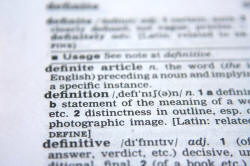Conjunctions

 |
Definitions |
A working definition of a conjunction is:
a word used to connect clauses or words within clauses
Can you identify the conjunctions in these examples? Work on the definition given, your knowledge of word class and your ability to identify clauses.
- It was raining but we went for a walk anyway.
- There was no bread and no butter.
- I came early so I could help you get ready.
- I don't know whether to laugh or cry.
- If you can let me know tomorrow, it would be a great help.
- I can give you a lift and I can take the dog, too.
Click here when you have an answer.
- It was raining but we went
for a walk anyway.
This conjunction joins two clauses together. You can't reverse the order of the clauses and keep the same meaning.
*We went for a walk anyway but it was raining
is nearly nonsense. - There was no bread and no
butter.
Here the conjunction and joins two noun phrases, no bread + no butter. We could replace it with something like There was no bread or butter and retain the same meaning. - I came early so I could
help you get ready.
This is similar to sentence 1. but you can reverse the clauses and get the same meaning:
So I could help you get ready, I came early - I don't know whether to
laugh or cry.
Here, we have a conjunction which comes in two parts. They operate together and must both be present to make any sense. - If you can let me know
tomorrow, it would be a great help.
This is a common conjunction but you can reverse the clauses and still retain the same basic meaning (albeit with a shift in emphasis). - I can give you a lift and I
can take the dog, too.
Here, the conjunction and is joining two clauses rather than two nouns, as in sentence 2., but the function is the same.
 |
5 things conjunctions can do |
Can you classify the conjunctions in the examples above into the following five categories? Click on the table when you have an answer.

 |
3 types of conjunctions |
Now we know what conjunctions do in sentences, we need to look at their grammar. In the examples
above, we have three sorts of conjunction.
In the last section, on sentences, you saw that some sentences contain
subordinate clause and some contain clauses of equal weight.
In the section on clauses, you saw how we have a matrix clause which can
contain either subordinate or coordinate clauses.
Now what you need to know is:
- Subordinating conjunctions join main clauses to subordinate clauses
- Coordinating conjunctions join clauses or noun phrases of equal weight
- Correlating conjunctions usually come in pairs and join two
clauses or two noun phrases.
Can you identify these three types in the example sentences? Here they are again with the conjunction in bold:
- It was raining but we went for a walk anyway.
- There was no bread and no butter.
- I came early so I could help you get ready.
- I don't know whether to laugh or cry.
- If you can let me know tomorrow, it would be a great help.
- I can give you a lift and I can take the dog, too.
Again, click on the table when you have an answer.

Some notes:
- Coordinating conjunctions can only be placed between the clauses or noun phrases they connect.
- Subordinating conjunctions on the other hand are a bit more
mobile. We can say, e.g.,
She came because I asked her
and
Because I asked her, she came
with approximately the same meaning (although the emphasis varies). However, some subordinating conjunctions require a certain ordering because of the logic of what we are saying. We can have, therefore,
He was bored so he went to see his friends
and we can have
He went to see his friends so he was bored
but the meaning is radically different. - Some of the correlating conjunctions (the ones with a negative
implication) sometimes require us to insert a question form so we
say,
Barely had I taken my seat when the play began
This is called inversion, incidentally (and slightly misleadingly).
 |
Lists |
Here's a list of some of the most common conjunctions in English, ordered by type, with examples. Your task is to think of examples of your own so you are sure you understand.
| Coordinating conjunctions | Example | Subordinating conjunctions | Example | Correlative conjunctions | Example |
| but | Not me but Mary | because | He came because I asked | whether ... or | I'll say it whether you want me to or not |
| so | I came so I could help | if | If you go now, you catch the bus | not only ... but (also) | He is not only attractive but he's also rich |
| for | I can't read for the light is too dim | although | He drove although he was drunk | as ... as | He is as stupid as the day is long |
| and | I went and saw him | than | He works harder than she does | both ... and | Both my sister and her husband came |
| or | Either you stay or go | before | He arrived before I was ready | no sooner ... than | I was no sooner in the bath than the phone rang |
| yet | He works hard yet he gets nowhere | why | That's why you dislike him | either ... or | She will either explain it or show you how to do it |
| nor | I won't go nor will I let you | when | I'll come when I like | rather ... than | I would rather have a tooth out than watch that |
The only complete list in the table above is column 1. There are only 7 coordinating conjunctions in English by most reckonings. The other lists can be extended very considerably.
 |
Learn more about: |
 |
Take a test |
To make sure you have understood so far, try
a very short test of your
knowledge of conjunctions.
Use the 'Back' button to return when you have done that.
If you got that all right, it is safe to move on.
That is the end of this section of the course. If you want to know more, go to the teacher training index and select the level you want. That will take you to a contents menu from which you can select what you need.
Click here to return to the course index.
